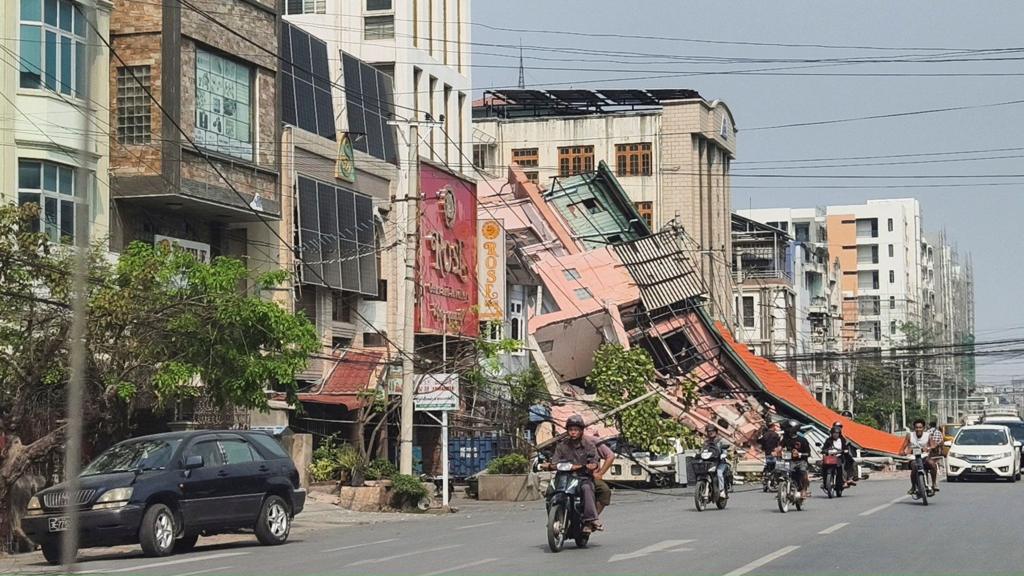More than 1,000 people have been killed in Myanmar and thousands more injured following a 7.7. magnitude earthquake that was also felt in neighbouring countries.
A rescue team in Mandalay, Myanmar's second largest city, tells the BBC: "We are digging people out with our bare hands."
"Infrastructure such as roads, bridges, and buildings were affected, leading to casualties and injuries among civilians. Search and rescue operations are currently being carried out in the affected areas," stated the report citing Myanmar’s military.
Most of the fatalities are in Mandalay, the country’s second largest city, and the region closest to the earthquake’s epicentre.
In the Thai capital Bangkok – located 1,000km from the epicentre in Myanmar – about 10 more deaths have been confirmed.
Officials say at least 15 people are believed to be alive under the rubble of a collapsed high-rise building with 100 people still unaccounted for.
“We are still trying to pull out the rest of the trapped people, but we need large machines. They are still shouting, and we can still hear their voices, but we can’t know where they are,” a rescue worker tell BBC as rescue workers are attempting to reach seven people trapped under a high-rise building in Mandalay.
Foreign rescue teams began flying into Myanmar on Saturday to aid the search for survivors from the deadly earthquake, reported Reuters.
The US Geological Service's predictive modelling estimated the death toll could exceed 10,000 in Myanmar and that losses could exceed the country's annual economic output.
The quake damaged roads, bridges and buildings in Myanmar, according to the junta, whose top general made a rare call for international assistance on Friday.
"Search and rescue operations are currently being carried out in the affected areas," the junta said in a statement on state media on Saturday.
Meanwhile Myanmar’s giant neighbours China and India have sent teams to help with rescue efforts, reported AP.
Being the military junta’s most important ally, as well as being one of its biggest trading partners, investing billions of dollars in mining, oil and natural gas developments in the resource-rich country, China was the responder sending its rescue group to Yangon on Saturday morning, according to Chinese state broadcaster CCTV.
A 37-member team from the Chinese province of Yunnan reached the city of Yangon early Saturday with earthquake detectors, drones and other supplies, it stated.
India said it had already sent a 80-member strong rescue and medical team, along with urgent humanitarian aid under Operation Brahma who will assist the rescue operations in Myanmar.
About 15-tonne relief material from India, including ready-to-eat meals, tents and generator sets, arrived in Yangon this morning, said media reports. It also sent blankets, tarpaulin, hygiene kits, sleeping bags, solar lamps, food packets and kitchen sets to the affected areas.
"We will continue to monitor the developments and more aid will follow," said Indian Foreign Minister Subrahmanyam Jaishankar on X on Saturday.
Russia was quick to follow China in deploying its own team of specialists, including dog teams, anesthesiologists and psychologists, the country’s emergencies ministry said.
Russia’s emergencies ministry dispatched two planes carrying 120 rescuers and supplies, according to a report from the Russian state news agency Tass.
The United Nations allocated $5 million to start relief efforts, while South Korea said it would provide an initial $2 million in humanitarian aid to Myanmar through international organisations.
The US, which has a testy relationship with the Myanmar military and has sanctioned its officials, including junta chief Min Aung Hlaing, has said it would provide some assistance.
President Donald Trump said Friday that the US was going to help with the response, but some experts were concerned about this effort given his administration’s deep cuts in foreign assistance.
Myanmar’s government meanwhile pointed out that blood was in high demand in the hardest-hit areas. In a country where prior governments sometimes have been slow to accept foreign aid, Min Aung Hlaing said Myanmar was ready to accept assistance.
Malaysia’s foreign ministry said the country will send 50 people on Sunday to help identify and provide aid to the worst-hit areas.
But amid images of buckled and cracked roads and reports of a collapsed bridge and a burst dam, there were concerns about how rescuers would even reach some areas in a country already enduring a humanitarian crisis.
Myanmar’s English-language state newspaper, Global New Light of Myanmar, said five cities and towns had seen building collapses and two bridges had fallen, including one on a key highway between Mandalay and Yangon.





















